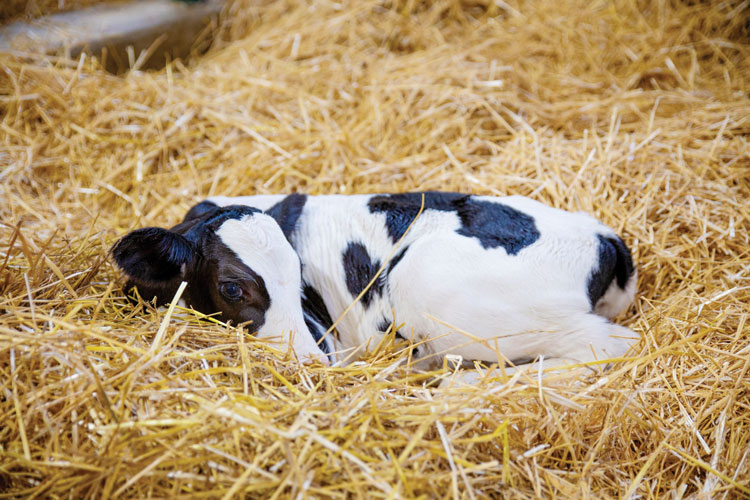
Calves enter a world filled with bacteria, viruses, and parasites. These organisms can make them sick or even lead to death.
It is a common belief that dairy calves are immunodeficient or immune compromised at birth, but according to veterinarian Amelia Woolums, that is not the case.
“A calf has a fully functioning immune system the day that it is born,” said the Mississippi State University professor during a Hoard’s Dairyman webinar earlier this year.
“It is an amazing system that is able to protect the calf on all fronts,” Woolums continued, applauding the immune system for protecting against a wide variety of pathogens and clearing infections without hurting the animal or the unborn fetus if the animal is pregnant. “The gastrointestinal tract, mammary, respiratory, the body surface . . . all of these surfaces are protected by things we can’t see with the naked eye, which is pretty astonishing.”
There are factors that influence how well a calf’s immune system will work, though. The dam’s health and nutrition and the calf’s genetic make-up and temperament play a role. Colostrum quality and handling, and then what a calf is fed after that, affect immunity, as do details like housing, stocking density, cleanliness, and temperature extremes.
Colostrum is the answer
Although it’s functional, a young calf’s immune system is naïve and immature. It reacts slower and weaker than the immune system of an older animal. How do we help improve this situation?
“Colostrum is nature’s solution to this problem,” Woolums stated. “I love talking about vaccination, but I do not think you can overcome real problems with inadequate colostrum intake with vaccination.”
She noted that multiple research trials show that calves without adequate colostrum are more likely to get sick, are more likely to die, and are less likely to reach their potential. Therefore, “Adequate colostrum intake is critical to calf health,” Woolums asserted.
For years, the industry emphasized the need to provide adequate colostrum intake, but new research shows that important health gains are made when calves receive excellent quality colostrum, Woolums explained. Because of this research, new colostrum recommendations were released a few years ago and are shown in the table.
“We used to use 5.2 g/dL of serum total solids as a cutoff for poor quality colostrum. Now we are aiming for 6.2 g/dL serum total solids (a brix reading of 9.4%) as the recommended cutoff for excellent passive transfer,” Woolums said. “There are important gains in health, less treatment for disease, and greater weight gain if we have more calves with excellent passive transfer.”
A National Animal Health Monitoring System (NAHMS) study sampled 1,623 heifers in 14 states. The results showed that about 40% of calves had either fair or poor blood antibody concentrations after colostrum feeding.
“We know that excellent transfer of passive immunity can improve health even more than adequate transfer,” Woolums said. “If aiming for excellent passive transfer, there is clearly room for improvement on many operations.”
Vaccination plays defense
Another tool in the immunity toolbox is vaccination. Why should we vaccinate calves?
“We want to keep animals healthy. We want to make sure they are meeting their potential for growth and production,” Woolums said.
She explained the difference between vaccination and immunization. “When we give a vaccine, we give a version of a virus or bacteria, which should induce an immune response, but it shouldn’t make the animal sick. This is vaccination,” she said. “If the animal’s immune system recognizes the agent in the vaccine and responds properly, the animal will have immunity to that agent. This is immunization.”
The first dose of a vaccination primes the immune system, generating some antibodies, mostly Immunoglobulin M (IgM). The booster results in more antibody production, including greater amounts of Immunoglobulin G.
“IgM is a good antibody, but IgG is able to do a lot more,” Woolums shared. “When we give a priming dose, followed by a booster, we get a much stronger and better immune response, and that is one of the principles of vaccination.”
The booster should be administered one to two months after the initial vaccination. When giving two doses, that doesn’t mean the calf is protected the day after the second dose, Woolums clarified. Aim to give the second one a month before disease exposure is expected to allow calves time to mount an immune response.
It doesn’t always work
Why might vaccinated calves get sick anyway? “There are many reasons why a vaccine may appear to fail, and it is not always the fault of a vaccine,” Woolums said.
Sometimes failure is due to how a vaccine is handled. For example, maybe the vaccine wasn’t stored at the proper temperature, or perhaps it wasn’t used quickly enough. If disinfectants were used to wash multidose syringes, Woolums said that can get into the plastic and kill the vaccine.
Poor timing of administration is also a problem if it does not allow enough time for an immune response or a booster is not given when needed.
The condition of the host animal can also be a reason for failure. This may be the case if the animal is already sick at the time of vaccination or is experiencing a nutritional deficiency. Vaccines can also be unsuccessful if the product used is not effective against the pathogen infecting the animals.
In the face of a disease outbreak among vaccinated cattle, Woolums said to work with your veterinarian to determine the most likely cause of this apparent vaccine failure. Likewise, before implementing any changes with your health programs, including vaccination protocols, Woolums advises discussing them first with your veterinarian.
Adult immune responses are present in dairy cattle by 5 to 8 months of age. Until then, it is up to us to help bolster that immune system through colostrum, vaccination, and effective management strategies. To learn more, watch the presentation by Woolums at on.hoards.com/WB_021323.









